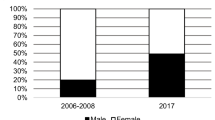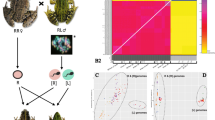Summary
Hybridogenetic species possess a hybrid genome: half is clonally inherited (hemiclonal reproduction) while the other half is obtained each generation by sexual reproduction with a parental species. We addressed the question of whether different hemiclones of the hybridogenetic water frogRana esculenta are locally adapted for genetic compatibility with their sexual parental hostRana lessonae. We artificially crossedR. esculenta females of three hemiclones (GUT1, GUT2 and GUT3) from a pond near Gütighausen, Switzerland and one hemiclone (HEL1) from near Hellberg, Switzerland each toR. lessonae males from both populations. We also created primary hybrids by crossing the sameR. lessonae males from both populations toR. ridibunda females from Poznań, Poland (POZ). Tadpoles were then reared in the laboratory at two food levels to assess their performance related to early larval growth rate, body size at metamorphosis and length of the larval period. Tadpoles from hemiclones GUT1, GUT3 and POZ had higher growth rates than those from hemiclones GUT2 and HEL1 at the low food level, but at the high food level all growth rates were higher and diverged significantly between hemiclones GUT2 and HEL1. Tadpoles from the intrapopulational crosses GUT2 × GUT and HEL1 × HEL were larger at metamorphosis than those from the interpopulational crosses GUT2 × HEL and HEL1 × GUT. A high food level increased the size at metamorphosis in all tadpoles. A high food level also decreased the days to metamorphosis and tadpoles from GUT1, GUT3 and POZ had the shortest larval period whereas those from GUT2 and HEL1 had the longest. These results indicate that the differential compatibility of clonal genomes may play an important role in hybridogenetic species successfully using locally adapted sexual genomes of parental species and that interclonal selection is likely important in determining the distribution of hemiclones among local populations.
Similar content being viewed by others
References
Abt, G. and Reyer, H.-U. (1993) Mate choice and fitness in a hybrid frog:Rana esculenta females preferRana lessonae males over their own.Behav. Ecol. Sociobiol. 32, 221–8.
Alford, R.A. and Harris, R.N. (1988) Effects of larval growth history on anuran metamorphosis.Am. Nat. 131, 91–106.
Angus, R.A. and Schultz, R.J. (1979) Clonal diversity in the unisexual fishPoeciliopsis monacha-lucida: a tissue graft analysis.Evolution 33, 27–40.
Bergen, K. (1994) Effects of the frequency ofRana lessonae andRana esculenta males on mate choice of hybridogenetic females. MSC thesis, University of Zürich.
Berger, L. (1983) Western Paleartic water frogs (Amphibia, Ranidae): systematics, genetics and population compositions.Experientia 39, 127–30.
Berger, L. (1990) On the origin of genetic systems in European water frog hybrids.Zool. Pol. 35, 5–32.
Berger, L. and Uzzell, T. (1977) Vitality and growth of progeny from different egg size classes ofRana esculenta L. (Amphibia, Salientia).Zool. Pol. 26, 291–317.
Berven, K.A. (1990) Factors affecting population fluctuations in larval and adult stages of the wood frog (Rana sylvatica).Ecology 71, 1599–608.
Berven, K.A. and Gill, D.E. (1983) Interpreting geographic variation in life-history traits.Am. Zool. 23, 85–97.
Blankenhorn, H.J. (1977) Reproduction and mating behavior inRana lessonae—Rana esculenta mixed populations. InThe Reproductive Biology of Amphibians (D.H. Taylor and S.I. Guttman, eds), pp. 389–410. Plenum Press, New York.
Blankenhorn, H.J., Heusser, H. and Notter, P. (1973) Zur Verbreitung vonRana esculenta Linnaeus undRana lessonae Camerano im Zürcher Oberland. Rev.Suisse Zool. 80, 662–6.
Blouin, M.S. (1992) Genetic correlations among morphometric traits and rates of growth and differentiation in the green tree frog,Hyla cinerea.Evolution 46, 735–44.
Bulger, A.J. and Schultz, R.J. (1982) Origins of thermal adaptation in northern versus southern populations of a unisexual hybrid fish.Evolution 36, 1041–50.
Bullini, L. (1994) Origin and evolution of animal hybrid species.Trends Ecol. Evol. 9, 422–6.
Dingle, H., Blau, W.S., Brown, C.K. and Hegmann, J.P. (1982) Population crosses and the genetic structure of milkweed bug life histories. InEvolution and Genetics of Life Histories (H. Dingle and J.P. Hegmann, eds), pp. 209–29. Springer-Verlag, New York.
Goater, C.P., Semlitsch, R.D. and Bernasconi, M.V. (1993) Effects of body size and parasite infection on the locomotory performance of juvenile toads,Bufo bufo.Oikos 66, 129–36.
Gosner, N. (1960) A simplified table for staging anuran embryos and larvae with notes on identification.Herpetologica 16, 183–90.
Graf, J.-D. and Polls Pelaz, M. (1989) Evolutionary genetics of theRana esculenta complex. InEvolution and Ecology of Unisexual Vertebrates (R.M. Dawley and J.P. Bogart, eds), pp. 289–302. New York State Museum Bulletin 466, Albany, NY.
Grossenbacher, K. (1988) Verbreitungsatlas der Amphibien der Schweiz.Doc. Faun. Helvetiae 7, 1–207.
Harris, R.N., Semlitsch, R.D., Wilbur, H.M. and Fauth, J.E. (1990) Local variation in the genetic basis of paedomorphosis in the salamanderAmbystoma talpoideum.Evolution 44, 1588–603.
Hotz, H. (1983) Genic diversity among water frog genomes inherited with and without recombination. PhD dissertation, University of Zürich.
Hotz, H. and Uzzell, T. (1982) Biochemically detected sympatry of two water frog species: two different cases in the Adriatic Balkans (Amphibia, Ranidae).Proc. Nat. Acad. Sci. Phil. 134, 50–79.
Keegan-Rogers, V. and Schultz, R.J. (1984) Differences in courtship aggression among six clones of unisexual fish.Animal Behav. 32, 1040–4.
Leberg, P.L. and Vrijenhoek, R.C. (1994) Variation among desert topminnows in their susceptibility to attack by exotic parasites.Conservat. Biol. 8, 419–24.
McCullagh, P. and Nelder, J.A. (1989)Generalized Linear Models, 2nd edn. Chapman & Hall, New York.
Moore, W.S. and Eisenbrey, A.B. (1979) The population structure of an asexual vertebrate,Poeciliopsis 2 monacha-lucida (Pisces: Poeciliidae).Evolution 33, 563–78.
Newman, R.A. (1988a) Genetic variation for larval anuran (Scaphiopus couchii) development time in an uncertain environment.Evolution 42, 763–73.
Newman, R.A. (1988b) Adaptive plasticity in development ofScaphiopus couchii tadpoles in desert ponds.Evolution 42, 774–83.
Pough, F.H. and Kamel, S. (1984) Post-metamorphic change in activity metabolism of anurans in relation to life history.Oecologia 65, 138–44.
Quattro, J.M., Avise, J.C. and Vrijenhoek, R.C. (1991) Molecular evidence for multiple origins of hybridogenetic fish clones (Poeciliidae:Poeciliopsis).Genetics 127, 391–8.
SAS Institute Inc. (1988)SAS/STAT User's Guide, Release 6.03 Ed. SAS Institute Inc., Cary, NC.
Schenck, R.A. and Vrijenhoek, R.C. (1986) Spatial and temporal factors affecting coexistence among sexual and clonal forms ofPoeciliopsis.Evolution 40, 1060–70.
Schultz, R.J. (1969) Hybridization, unisexuality, and polyploidy in the teleostPoeciliopsis (Poeciliidae) and other vertebrates.Am. Nat. 103, 605–19.
Schultz, R.J. (1971) Special adaptive problems associated with unisexual fishes.Am. Zool. 11, 351–60.
Schultz, R.D. (1982) Competition and adaptation among diploid and polyploid clones of unisexual fishes. InEvolution and Genetics of Life Histories (H. Dingle and J.P. Hegmann, eds), pp. 103–19. Springer-Verlag, New York.
Semlitsch, R.D. (1993a) Asymmetric competition in mixed populations of tadpoles of the hybridogeneticRana esculenta complex.Evolution 47, 510–19.
Semlitsch, R.D. (1993b) Adaptive genetic variation in growth and development of tadpoles of the hybridogeneticRana esculenta complex.Evolution 47, 1805–18.
Semlitsch, R.D. and Reyer, H.-U. (1992) Performance of tadpoles from the hybridogeneticRana esculenta complex: interactions with pond drying and interspecific competition.Evolution 46, 665–76.
Semlitsch, R.D., Scott, D.E. and Pechmann, J.H.K. (1988) Time and size at metamorphosis related to adult fitness inAmbystoma talpoideum.Ecology 69, 184–92.
Smith, D.C. (1983) Factors controlling tadpole populations of the chorus frog (Pseudacris triseriata) on Isle Royale.Ecology 64, 501–10.
Smith, D.C. (1987) Adult recruitment in chorus frogs: effects of size and date at metamorphosis.Ecology 68, 344–50.
Travis, J. (1980) Phenotypic variation and the outcome of interspecific competition in hylid tadpoles.Evolution 34, 40–50.
Travis, J. (1981) The control of larval growth variation in a population ofPseudacris triseriata (Anura: Hylidae).Evolution 35, 423–32.
Travis, J. (1984) Anuran size at metamorphosis: experimental test of a model based on intraspecific competition.Ecology 65, 1155–60.
Travis, J., Keen, W.H. and Juilianna, J. (1985) The effects of multiple factors on viability selection inHyla gratiosa tadpoles.Evolution 39, 1087–99.
Travis, J., Emerson, S.B. and Blouin, M. (1987) A quantitative—genetic analysis of larval life-history traits inHyla crucifer.Evolution 41, 145–56.
Tunner, H.G. and Heppich-Tunner, S. (1991) Genome exclusion and two strategies of chromosome duplication in oogenesis of a hybrid frog.Naturwissenschaften 78, 32–4.
Tunner, H.G. and Nopp, H. (1979) Heterosis in the common European waterfrog.Naturwissenschaften 66, 268–9.
Uzzell, T. and Berger, L. (1975) Electrophoretic phenotypes ofRana ridibunda, Rana lessonae, and their hybridogenetic associate,Rana esculenta.Proc. Acad. Nat. Sci. Phil. 127, 13–24.
Vrijenhoek, R.C. (1984) Ecological differentiation among clones: the frozen niche variation model. InPopulation Biology and Evolution (K. Wöhrmann and V. Loeshcke, eds), pp. 217–31. Springer-Verlag, Berlin.
Vrijenhoek, R.C., Angus, R.A. and Schultz, R.J. (1977) Variation and heterozygosity in sexually vs. clonally reproducing populations ofPoeciliopsis.Evolution 31, 767–81.
Weeks, S.C., Gaggiotti, O.E., Schenck, R.A., Spindler, K.P. and Vrijenhoek, R.C. (1992) Feeding behavior in sexual and clonal strains ofPoeciliopsis.Behav. Ecol. Sociobiol. 30, 1–6.
Wetherington, J.D., Kotora, K.E. and Vrijenhoek, R.C. (1987) A test of the spontaneous heterosis hypothesis for unisexual vertebrates.Evolution 41, 721–31.
Wetherington, J.D., Weeks, S.C., Kotora, K.E. and Vrijenhoek, R.C. (1989) Genotypic and environmental components of variation in growth and reproduction of fish hemiclones (Poeciliopsis: Poeciliidae).Evolution 43, 635–45.
Wilbur, H.M. (1990) Coping with chaos: toads in ephemeral ponds.Trends Ecol. Evol. 5, 37.
Wilbur, H.M. and Collins, J.P. (1973) Ecological aspects of amphibian metamorphosis.Science 182, 1305–14.
Woodward, B.D. (1983) Tadpole size and predation in the Chihuahuan desert.Southwestern Nat. 28, 470–1.
Author information
Authors and Affiliations
Rights and permissions
About this article
Cite this article
Semlitsch, R.D., Schmiedehausen, S., Hotz, H. et al. Genetic compatibility between sexual and clonal genomes in local populations of the hybridogeneticRana esculenta complex. Evol Ecol 10, 531–543 (1996). https://doi.org/10.1007/BF01237883
Issue Date:
DOI: https://doi.org/10.1007/BF01237883




